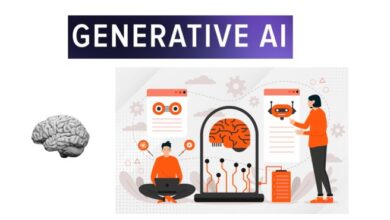
Google AIs Environmental Impact: A Deep Dive
Google ai environmental impact – Google AI’s environmental impact is a topic that’s increasingly gaining attention, and for good reason. As AI technology becomes more powerful and ubiquitous, its energy consumption and carbon footprint are becoming significant factors. This post delves into the complexities of Google AI’s environmental impact, exploring its energy requirements, carbon footprint, sustainability initiatives, and the potential of AI for environmental solutions.
We’ll examine how Google is striving to mitigate the environmental impact of its AI operations, including its commitment to renewable energy sources and its development of AI applications for climate change mitigation. We’ll also discuss the ethical considerations surrounding AI’s environmental footprint, highlighting the importance of responsible development and deployment.
Google AI’s Energy Consumption
Google’s AI models and data centers require substantial energy to function. This energy consumption is driven by the massive computational power needed to train and run these models.
Energy Requirements of Google AI Models and Data Centers
The energy requirements of Google AI models and data centers are substantial. The training of large language models (LLMs) like BERT and LaMDA requires enormous computational resources. These models are trained on massive datasets, which involve complex mathematical operations and data processing.
The energy consumption during this training phase can be significant, measured in megawatt-hours. Google’s data centers, which house these models and provide the infrastructure for their operation, also contribute significantly to the company’s overall energy consumption. These data centers require energy for cooling, power supply, and server operation.
Comparison of Google AI’s Energy Consumption with Other Industries
The energy consumption of Google AI, particularly for training large models, is comparable to that of entire cities. For example, the training of OpenAI’s GPT-3 model, a large language model similar in scale to Google’s models, was estimated to have consumed the energy equivalent of hundreds of homes for a year.
While this energy consumption is substantial, it’s important to consider it in the context of the benefits these models provide. AI models are used in various applications, including healthcare, finance, and climate change research, which have the potential to significantly impact society.
Google’s Efforts to Reduce its Energy Footprint
Google has implemented several initiatives to reduce its energy footprint. The company has invested in renewable energy sources, such as solar and wind power, to power its data centers. Google has also optimized its data center infrastructure, using more efficient cooling systems and server designs.
Furthermore, the company has developed AI-powered tools to optimize energy usage in its data centers, further reducing its energy consumption.
Carbon Footprint of Google AI: Google Ai Environmental Impact

Google AI, with its transformative potential, comes with a significant environmental footprint. This footprint stems from the massive energy consumption required for data storage, processing, and the development and training of AI models. Understanding the environmental impact of Google AI is crucial for mitigating its potential negative effects and promoting sustainable AI development.
It’s amazing how Google AI is used in so many areas, even in our homes! For example, the energy efficiency of appliances is constantly being improved by AI algorithms. And speaking of home improvements, I recently gave my washer and dryer a makeover with stripes and dots – check out the results on this blog post.
Of course, the impact of AI on the environment is a complex issue, but it’s encouraging to see it being used to create more sustainable solutions, like reducing energy consumption in our homes.
Data Storage and Processing
The environmental impact of Google AI’s data storage and processing is significant. Google’s data centers consume vast amounts of electricity to power servers, cooling systems, and other infrastructure. The energy used for these operations contributes to greenhouse gas emissions.
- Data Storage:Google’s massive data centers house petabytes of data, requiring substantial energy for maintaining storage infrastructure. The energy required for data storage scales with the volume of data stored. For example, storing a single gigabyte of data for a year can consume approximately 100 kilowatt-hours of electricity.
- Data Processing:AI models require extensive computational power for training and inference. This processing consumes substantial energy, contributing to the carbon footprint of Google AI. The energy required for processing depends on the complexity of the model, the size of the training dataset, and the duration of training.
Development and Training Processes
The development and training of AI models also contribute to Google AI’s carbon footprint. The energy consumed during these processes depends on the complexity of the model, the size of the training dataset, and the duration of training.
It’s fascinating to think about the environmental impact of Google’s AI, especially as it becomes more integrated into our lives. From powering search results to driving self-driving cars, the energy demands are significant. But on a smaller scale, we can all make eco-conscious choices, like crafting our own nail polish shelves instead of buying pre-made ones.
Make your own nail polish shelves is a great way to personalize your space while reducing waste. Just like Google’s AI, we can all strive for sustainability in our own way, even in the little things.
- Model Development:The development of AI models involves extensive experimentation and optimization, which requires significant computational resources. The energy consumed during model development contributes to the carbon footprint of Google AI.
- Model Training:Training AI models involves feeding large datasets to the model, allowing it to learn patterns and make predictions. The training process is computationally intensive, consuming vast amounts of energy. For instance, training a large language model like GPT-3 can consume the energy equivalent of several homes for a year.
Environmental Sustainability Initiatives
Google AI is committed to developing and deploying artificial intelligence (AI) in an environmentally responsible manner. The company recognizes the potential impact of AI on the environment and has taken significant steps to minimize its footprint.
Google AI’s Sustainability Initiatives, Google ai environmental impact
Google AI has implemented various initiatives to promote environmental sustainability. These initiatives encompass a range of activities, including partnerships, programs, and internal policies.
- Partnerships with Environmental Organizations:Google AI collaborates with environmental organizations to leverage AI for conservation efforts. For example, Google AI has partnered with the World Wildlife Fund (WWF) to develop AI-powered tools for wildlife monitoring and habitat conservation. These tools use machine learning algorithms to analyze images and videos of wildlife, identifying species and tracking their movements.
The environmental impact of Google AI is a complex issue, with the energy consumption of massive data centers and the potential for bias in algorithms raising concerns. But while we grapple with these challenges, there’s still room for simple pleasures, like hosting a New Year’s Eve wine bar.
A DIY ice bucket, like the one described here , can keep your bubbly chilled while you toast to a brighter future, one where technology and sustainability coexist.
- Sustainable AI Development Programs:Google AI has launched several programs to encourage the development of sustainable AI solutions. The Google AI for Social Good program provides grants and resources to researchers and developers working on AI projects with positive social and environmental impacts. Additionally, Google AI has established a dedicated team focused on developing AI solutions for climate change mitigation and adaptation.
- Internal Sustainability Policies:Google AI has implemented internal policies to promote sustainability within its own operations. These policies include energy efficiency measures, waste reduction initiatives, and the use of renewable energy sources. For example, Google AI has committed to using 100% renewable energy for its data centers and offices globally.
Google’s Commitment to Renewable Energy
Google’s commitment to renewable energy is evident in its investments in renewable energy projects worldwide.
| Year | Renewable Energy (MW) | Renewable Energy Source |
|---|---|---|
| 2020 | 5,800 | Solar, wind, geothermal |
| 2021 | 6,500 | Solar, wind, geothermal, hydroelectric |
| 2022 | 7,200 | Solar, wind, geothermal, hydroelectric, biomass |
Google’s Vision for Environmentally Responsible AI
“We believe that AI can be a powerful force for good in the world, and that it should be developed and deployed in a way that is both beneficial and sustainable. We are committed to using AI to address some of the world’s most pressing environmental challenges, and we are working to ensure that our own AI systems are developed and used in a way that is environmentally responsible.”
Google AI
AI’s Potential for Environmental Solutions
AI has the potential to revolutionize how we address environmental challenges, from climate change mitigation to resource management. Google AI, with its advanced algorithms and vast computational resources, is actively contributing to this revolution.
Google AI’s Role in Climate Change Mitigation
Google AI is developing and deploying innovative AI solutions to combat climate change.
- Predicting and Preventing Wildfires: Google AI is developing AI models that analyze various data sources, including satellite imagery, weather patterns, and historical fire data, to predict wildfire risks with greater accuracy. These predictions allow for early intervention and prevention measures, minimizing the impact of wildfires on ecosystems and human communities.
- Optimizing Renewable Energy Production: Google AI is optimizing renewable energy sources like solar and wind power. By analyzing weather patterns, energy demand, and grid infrastructure, AI models can improve energy generation efficiency and reduce reliance on fossil fuels.
- Developing Sustainable Materials: Google AI is working on developing sustainable materials using machine learning. By analyzing the properties of different materials and their environmental impact, AI can accelerate the discovery and development of eco-friendly alternatives.
Google AI for Resource Management and Conservation
Google AI is helping to optimize resource management and conservation efforts.
- Monitoring Deforestation: Google AI uses satellite imagery and machine learning to monitor deforestation rates and identify illegal logging activities. This information helps to protect forests and biodiversity, crucial for mitigating climate change and maintaining ecosystem health.
- Improving Water Resource Management: Google AI is developing AI models to optimize water usage in agriculture and urban environments. By analyzing water demand, rainfall patterns, and soil conditions, AI can help farmers and city planners manage water resources more efficiently, reducing water scarcity and waste.
- Optimizing Waste Management: Google AI can be used to improve waste management systems. By analyzing waste composition and recycling rates, AI can help cities and communities optimize waste collection routes, recycling processes, and landfill management.
Ethical Considerations of Google AI
The environmental impact of Google AI, while contributing to advancements in various fields, raises significant ethical considerations. Balancing the benefits of AI with its environmental footprint is crucial for ensuring responsible and sustainable development.
Ethical Implications of Google AI’s Environmental Impact
The environmental impact of Google AI’s operations, including data centers and training models, raises ethical concerns about resource consumption and carbon emissions. This impact can disproportionately affect vulnerable communities and exacerbate existing environmental inequalities. For instance, the energy demands of AI training can contribute to increased greenhouse gas emissions, potentially exacerbating climate change and its consequences.
Potential Risks and Challenges Associated with AI’s Environmental Footprint
Several risks and challenges are associated with AI’s environmental footprint:
- Increased Energy Consumption:The training of large language models requires substantial computational power, leading to increased energy consumption and carbon emissions. This energy demand can strain power grids and contribute to environmental pollution.
- Resource Depletion:The production of hardware components for AI systems, such as processors and memory chips, relies on scarce resources like rare earth minerals. This dependence can contribute to resource depletion and environmental degradation.
- Data Center Expansion:The growing need for data storage and processing for AI applications drives the expansion of data centers. This expansion can contribute to land use changes, habitat loss, and increased energy consumption.
Importance of Responsible AI Development and Deployment
Responsible AI development and deployment are crucial to mitigate the ethical implications of its environmental impact. This involves prioritizing sustainability in the design, training, and operation of AI systems.
- Energy Efficiency:Implementing energy-efficient algorithms, hardware optimization, and data center infrastructure can significantly reduce AI’s energy footprint.
- Sustainable Data Management:Employing techniques like data compression, data deduplication, and efficient data storage can minimize the environmental impact of data storage and processing.
- Transparency and Accountability:Openly communicating AI’s environmental footprint, including energy consumption and carbon emissions, fosters transparency and accountability in the field.




